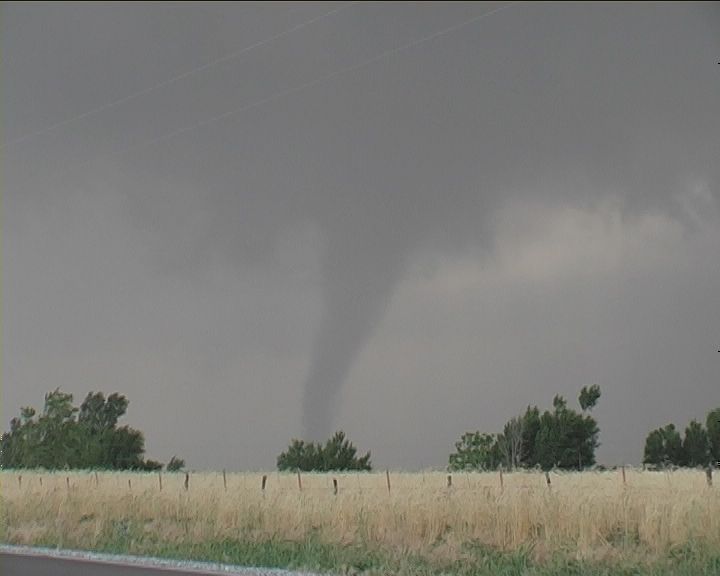Scott Olson
EF5
Just curious how rare exactly are anticyclonic tornadoes? There seems to be a great deal of attention of the Sunnyvale tornado but I have also read of several such instances (even some from 2004) of anti-cyclonic tornadoes. Certainly splitting isn't that rare but usually the right mover would be the one to be worried about.
Why do I bring this up?
On May 20th of this year I returned from Kansas from a futile two-day trip down to the southern plains. The day had a moderate risk for E MT - NW SD and extreme SW ND. With a slight risk extending to E ND. I targeted E ND which was far from the surface low and shortwave farther west but had a warm front, backed flow and sufficent instability and shear to make it look decent. Another positive was that the SAT showed it entirely sunny and both the NAM and RUC had strong QPF over the entire area by 21z. I believe the 1630z outlook added the area into the 2% tornado risk zone.
In the mid-afternoon an unimpressive cluster of storms formed in EC ND and slowly moved Eastward. After about twenty minutes the southernmost
cell and even the northernmost cell looked most appealing with several embedded cells in between.

Now what happend next suprised me a little. A look at the SPC mesoanaylsis page did bring my hopes up since these cells were moving into an environment increasingly favorable for development. I remember an 8 indicies bullseye on the supercell composite parameter just east of these cells. (Way to go Rich!). Orignally I was just SE of the northernmost cell observing a very low and nice shelf when the NWS issued a tornado warning. BR1 still made the storm look dis-organized and weak but a look at a tilt of 19.5 showed 67dbz at 17,000 ft and a mid-level mesocyclone around Hatton, ND. As I jockeyed around trying to find this tornado the storm exploded and turned into a left mover. It was now clear the tornado was occuring on the left rear flank. About twenty minutes later the southernmost cell which had nearly died out, took on a hook echo and classic supercell charestics as it took a hard turn to the right of the wind vector. While the cells in the middle continued there journey eastward.
Left mover during tornado producing stage:

Velocity image on left rear flank of storm:

Forty minutes later after the left mover puts down three reported tornadoes and begins to weaken the right mover starts to really crank up and puts down a tornado of its own.

I never got a chance to check the offical NWS survey but it did end up in SPC storm reports orignally as reported. Any links to the survey are appreciated as well as discussions on how rare or how common anticyclonic tornadoes really are.
Why do I bring this up?
On May 20th of this year I returned from Kansas from a futile two-day trip down to the southern plains. The day had a moderate risk for E MT - NW SD and extreme SW ND. With a slight risk extending to E ND. I targeted E ND which was far from the surface low and shortwave farther west but had a warm front, backed flow and sufficent instability and shear to make it look decent. Another positive was that the SAT showed it entirely sunny and both the NAM and RUC had strong QPF over the entire area by 21z. I believe the 1630z outlook added the area into the 2% tornado risk zone.
In the mid-afternoon an unimpressive cluster of storms formed in EC ND and slowly moved Eastward. After about twenty minutes the southernmost
cell and even the northernmost cell looked most appealing with several embedded cells in between.

Now what happend next suprised me a little. A look at the SPC mesoanaylsis page did bring my hopes up since these cells were moving into an environment increasingly favorable for development. I remember an 8 indicies bullseye on the supercell composite parameter just east of these cells. (Way to go Rich!). Orignally I was just SE of the northernmost cell observing a very low and nice shelf when the NWS issued a tornado warning. BR1 still made the storm look dis-organized and weak but a look at a tilt of 19.5 showed 67dbz at 17,000 ft and a mid-level mesocyclone around Hatton, ND. As I jockeyed around trying to find this tornado the storm exploded and turned into a left mover. It was now clear the tornado was occuring on the left rear flank. About twenty minutes later the southernmost cell which had nearly died out, took on a hook echo and classic supercell charestics as it took a hard turn to the right of the wind vector. While the cells in the middle continued there journey eastward.
Left mover during tornado producing stage:

Velocity image on left rear flank of storm:

Forty minutes later after the left mover puts down three reported tornadoes and begins to weaken the right mover starts to really crank up and puts down a tornado of its own.

I never got a chance to check the offical NWS survey but it did end up in SPC storm reports orignally as reported. Any links to the survey are appreciated as well as discussions on how rare or how common anticyclonic tornadoes really are.


